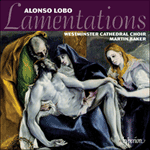
Welcome to Hyperion Records, a British classical label devoted to presenting high-quality recordings of music of all styles and from all periods from the twelfth century to the twenty-first.
Hyperion offers both CDs, and downloads in a number of formats. The site is also available in several languages.
Please use the dropdown buttons to set your preferred options, or use the checkbox to accept the defaults.

| Westminster Cathedral Choir, Martin Baker (conductor)» More |
Guerrero’s motet is composed of series of melodic points that are worked in imitation, some plainly, some in inversion, others stretched or compressed, all frequently animated with ornamental running figures. These are the materials that Lobo transforms into a great edifice that is his own, but one that remains his homage to the older master. The opening phrases of the motet are striking, and it is to them that Lobo frequently returns. The process of reinvention is all-pervading, but we may pick out how Lobo adopts and adapts the ‘Alleluia’ ending of Guerrero’s first half and transforms it into the ‘Amen’ to close his Gloria. The repeated ‘Osanna’ section that completes both Sanctus and Benedictus is a transformation of the polyphonic web into what is now called compound triple time, spiced with syncopation as the voices clamour for attention, displacing their accents and misbehaving with the pulse.
from notes by Bruno Turner © 2016
Le motet de Guerrero se compose d’une série de points mélodiques qui sont travaillés en imitation, certains simplement, certains en inversion, d’autres étendus ou condensés, tous étant souvent animés par des figures ornementales ininterrompues. Tels sont les matériels que Lobo transforme en un grand édifice qui lui est propre, mais qui reste son hommage au vieux maître. Les premières phrases du motet sont frappantes et c’est à elles que Lobo revient souvent. Le processus de réinvention se ressent partout, mais l’on peut retrouver comment Lobo adopte et adapte la fin «Alléluia» de la première moitié de Guerrero et la transforme en son «Amen» pour conclure son Gloria. La section «Hosanna» répétée qui termine le Sanctus comme le Benedictus est une transformation du tissu polyphonique en ce qui s’appelle maintenant une mesure ternaire à trois temps, pimentée de syncopes lorsque les voix réclament l’attention, déplaçant leurs accents et maltraitant le rythme.
extrait des notes rédigées par Bruno Turner © 2016
Français: Marie-Stella Pâris
Guerreros Motette besteht aus einer Reihe melodischer Formeln, die imitierend verarbeitet werden—unverändert, in Umkehrung, vergrößert oder verkleinert und häufig mit Lauffiguren verziert. Dieses Material verwandelt Lobo in ein Klanggebäude, das ganz seine Schöpfung ist, seinem alten Meister jedoch verpflichtet bleibt. Regelmäßig kehrt Lobo zu den prägnanten Anfangsphrasen der Motette zurück. Dieser Verwandlungsprozess ist allgegenwärtig; als Beispiel mag Lobos Anverwandlung des „Alleluia“ dienen, mit dem Guerrero den ersten Teil beschließt: Es wird zum „Amen“ seines Gloria-Satzes. Der wiederholte „Osanna“-Abschnitt, der sowohl das Sanctus als auch das Benedictus beschließt, ist eine Umgestaltung der mehrstimmigen Textur zu einem—nach heutiger Terminologie—zusammengesetzten Dreiertakt, durchsetzt mit Synkopen im Wettstreit der Stimmen, die ihre Akzente verschieben und den Grundschlag ignorieren.
aus dem Begleittext von Bruno Turner © 2016
Deutsch: Friedrich Sprondel
 Lobo: Lamentations & other sacred music Lobo: Lamentations & other sacred musicOne of the masterpieces of Renaissance polyphony, from a choir steeped in the performance traditions of such music.» More |

